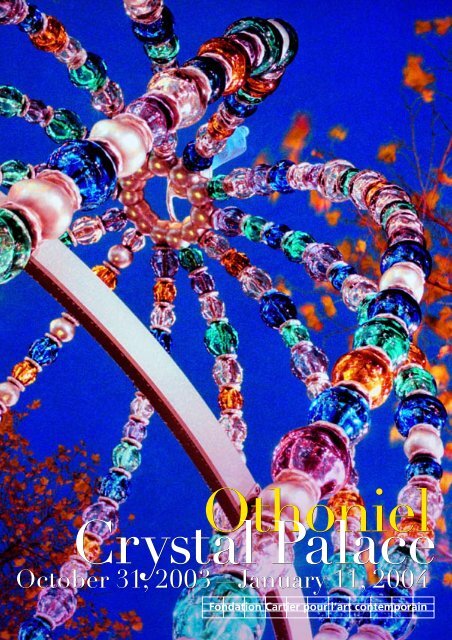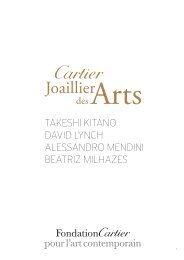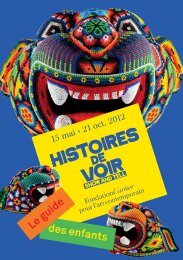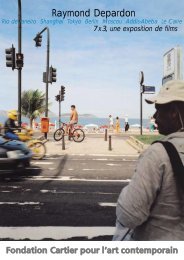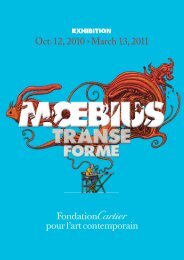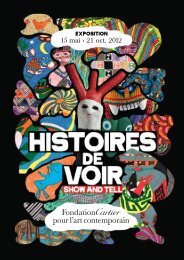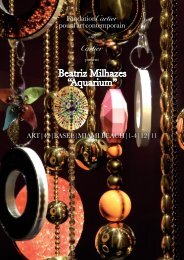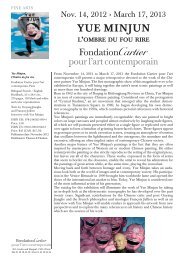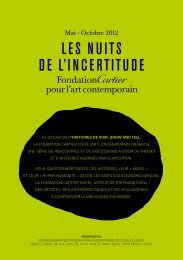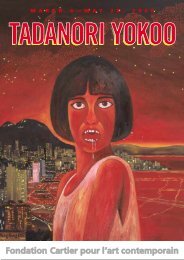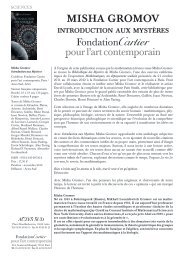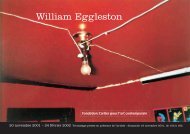OTHONIEL VERS PDF ANG - Fondation Cartier pour l'art ...
OTHONIEL VERS PDF ANG - Fondation Cartier pour l'art ...
OTHONIEL VERS PDF ANG - Fondation Cartier pour l'art ...
You also want an ePaper? Increase the reach of your titles
YUMPU automatically turns print PDFs into web optimized ePapers that Google loves.
Othoniel<br />
Crystal Palace<br />
October 31, 2003—January 11, 2004
Press release<br />
Press Opening on Thursday, October 30, 2003 at 3:00 pm<br />
The <strong>Fondation</strong> <strong>Cartier</strong> <strong>pour</strong> l’art contemporain<br />
presents Crystal Palace, a unique exhibition by Othoniel,<br />
from October 31, 2003 to January 11, 2004.<br />
After taking part in the artist’s workshops in Jouy-en-Josas (1989) and<br />
after participating in the Azur (1993) and Amours (1997) exhibitions,<br />
Othoniel is back with an original project entirely conceived as a pendant<br />
to Jean Nouvel’s glass building. In much the same spirit as his<br />
Kiosque des Noctambules (2000) which re-interpreted, after Hector<br />
Guimard, the entrance to the Palais-Royal subway station, he invites the<br />
public to take another walk, this time through the ground floor spaces<br />
and into the gardens of the <strong>Fondation</strong> <strong>Cartier</strong>.<br />
His interest in metamorphoses, sublimations, and<br />
transmutations led Jean-Michel Othoniel (born<br />
in 1964; lives in Paris) to privilege materials with<br />
reversible properties. His sculptures in sulfur, lead, wax or<br />
phosphorus attracted attention, and he rapidly emerged<br />
on the international scene, exhibiting in Paris, Tokyo, New<br />
York, Berlin… His sources of inspiration are minimalism<br />
and Arte povera, the artistic expressions of Broodthaers or<br />
Duchamp, and, in the literary field, Borges, Gracq, and<br />
Roussel. A special fascination—at once melancholic and<br />
scientific—for the major developments of the 19th century<br />
(photography, traveling, museums…), impelled him in<br />
the late ‘80s to embrace other forms of creativity, including<br />
sculpture, drawing, photography, writing, dance and<br />
video.<br />
In 1992 he was invited to show some of his sulfur<br />
sculptures in the Documenta in Kassel, Germany. In 1994<br />
he participated in the Féminin/Masculin exhibition at the<br />
Pompidou Center where he presented one of his major<br />
works, My Beautiful Closet.<br />
It was in 1993 that Othoniel irremediably introduced<br />
glass into his work. He began experimenting with its properties<br />
together with master glassmaker, Oscar Zanetti, in<br />
Murano. The artist molds the desired shapes in clay, and<br />
the master glassmaker then takes them and reproduces<br />
them along with their formal imperfections and irregularities.<br />
“Glass has a memory. If you injure a ball of melted<br />
glass by making an incision or any kind of cut into it, the<br />
glass will heal up. But once it cools, the wound will reappear.<br />
So Zanetti used these wounds to create some of the<br />
shapes I was looking for.”<br />
Blown-glass beads were thus made in Venice, as well as<br />
at the CIRVA—the International Glass Art Research Center<br />
founded in Marseille in 1986—and then fashioned into<br />
necklaces and enigmatic harnesses, a combination of jewelry,<br />
decoration and erotica.<br />
Transformation, transmutation of matter, rites of passage<br />
from one state to another, all of these reflect another rite<br />
which is fundamental to the artist’s work, that of traveling,<br />
with the memories brought back from gardens<br />
explored or secluded dwellings. In these spaces of ultimate<br />
freedom, open to reversibility and chance encounters,<br />
Othoniel sets up his glass creations for the fleeting<br />
pleasure of a temporary traveling companion—who is<br />
both a stranger and an accomplice. Thus, in 1996 his<br />
necklaces were suspended among the bamboo in the Villa<br />
Medicis gardens in Rome, then from the trees in the<br />
Venetian gardens of the Peggy Guggenheim Collection,<br />
and in 1999 in the Alhambra and the Generalife in<br />
Grenada. His pieces live, mingle with the old stones or<br />
the foliage, like so many organic excrescences that absorb<br />
Harnais, 1997<br />
Garden of the Peggy Guggenheim Collection, Venice<br />
Private collection, Paris<br />
Above left:<br />
Les amants suspendus, 1999<br />
Collection of the artist
the shadows and diffract the light. “I like to give visitors<br />
the impression that they are alone with the work in an<br />
enclosed Garden of Eden, an exotic seraglio somewhere<br />
outside of this world. My glass sculptures are to be discovered<br />
walking among them.”<br />
Like the tour through Roussel’s Locus Solus park of wondrous<br />
inventions, the Crystal Palace exhibition could start<br />
off in the gardens of the <strong>Fondation</strong> <strong>Cartier</strong>.<br />
A medley of ten poles, each richly decorated at the top<br />
like so many lofty banner bearers, greets the visitor, inviting<br />
him or her to take a stroll through this dreamily-named<br />
Cortège endormi. Up in the air, beads and pendants sway in<br />
the wind, are illuminated with solar rays, describe a celestial<br />
course, suggest a path that can always diverge…<br />
The pieces presented in the exhibition were specifically<br />
created for Crystal Palace with the help and expertise<br />
of the CIRVA. The transformation took place in their blast<br />
furnaces, the violence of the fire turning the silica first to<br />
liquid, then making it malleable, transparent or opalescent,<br />
an iridescent rainbow of astonishing colors.<br />
Othoniel’s obsessions—desire, pleasure, sensuality, the<br />
erotic, the religious—are to be found in this metamor-<br />
phosis. In it, one sees the gesture, the hand that worked<br />
it. One thinks of the numerous ex-votos in the chapels<br />
of Naples.<br />
The visitor might also come across one of his gigantic<br />
necklaces hanging from a tree, a reference to the absent<br />
body which has haunted the artist’s work for many years.<br />
Poles and necklaces are also on display in the various<br />
spaces inside the <strong>Fondation</strong> <strong>Cartier</strong>.Those on the “inside”<br />
are visible from the “outside”, and vice versa, showing off<br />
their glittering colors, their transparency, the transparency<br />
of the building. Hanging from a metal cable, the necklaces<br />
lie heavily on the ground. Crystal beads inlaid with golden<br />
leaves, silver beads, deep amethyst or amber.<br />
In a rain of gold, Pluie d’or, two immense embroidered<br />
veils interrupt the gaze and offer, here and there, via<br />
restricted openings, a few indiscreet windows set off by<br />
gold sequins. The thrill of being a voyeur. Delicate expression<br />
of another type of handicraft, the embroiderers of<br />
Rochefort and their nimble fingers gliding over the fabric.<br />
One discovers, through the theatricality of the curtain, a<br />
stately bed with a glass canopy, fragile, yet imposing, created<br />
by the Salviati glassblowers in Murano, masters in the<br />
art since the 19th century. Once again, the hands-on gesture<br />
is delegated. “Since I started using glassmakers to<br />
make my works, I’ve become used to dealing with interpretations<br />
of my own proposals. I’m also able to recognize<br />
myself in someone else’s handiwork, a bit like a composer<br />
listening to the music he has written being played by a performer<br />
he has chosen.” As for the felt quilt, it provides a<br />
glimpse into the subtle, quasi-ascetic art of haberdashery.<br />
As daylight fades, the blown-glass lanterns shed halos<br />
of shimmering gold over the spaces. Refraction of light<br />
and colors in every glass cabochon. Isolated from the rest<br />
of the Cortège endormi, the Unicorne, a mock sedan-chair<br />
that looks too fragile to be safe, sits royally on its silver<br />
trestles.<br />
The Fontaine du plaisir et des larmes, with its little elements<br />
of glossy, glowing molten glass, is a fountain of<br />
frustrated temptation, evoking the pleasure one would<br />
feel if one could just run one’s fingers over its curves, an<br />
allusion to the forbidden caress.<br />
Across from Paysage amoureux, a bead curtain that is<br />
over 10 meters long, the piece Lagrimas allows the imagination<br />
to drift through an aquatic world peopled by<br />
mysterious Cartesian divers.<br />
L’arbre aux colliers, 2003<br />
Garden of the Museum of Modern Art, New Orleans<br />
Collection Sidney Besthoff<br />
First page:<br />
Le Kiosque des Noctambules, 2000<br />
Palais-Royal—Musée du Louvre Metro Station, Paris<br />
© RATP – Photo Gilles Aligon<br />
Othoniel, Crystal Palace will be accompanied by a bilingual<br />
(French/English) catalogue and will be presented at the<br />
Museum of Contemporary Art, North Miami from May 28<br />
to August 31, 2004.<br />
Press Information<br />
Linda Chenit assisted by Nathalie Desvaux<br />
tel. 33 (0)1 42 18 56 77/65 fax 33 (0)1 42 18 56 52<br />
email lchenit@fondation.cartier.fr<br />
online images/fondation.cartier.fr<br />
261, boulevard Raspail 75014 Paris<br />
Tel. 33 (0)1 42 18 56 50 fax 33 (0)1 42 18 56 52<br />
fondation.cartier.fr<br />
The Othoniel, Crystal Palace exhibition is organized with the support<br />
of the <strong>Fondation</strong> <strong>Cartier</strong> <strong>pour</strong> l’art contemporain under the aegis<br />
of the <strong>Fondation</strong> de France, and with the sponsorship of <strong>Cartier</strong>.


